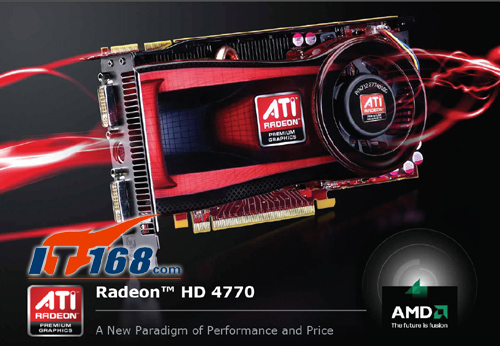AMD's Radeon HD 4770 Specs Revealed
According to leaked reports, it looks as though AMD finally released the specs of the Radeon HD 4770, the upcoming graphics card based on the 40nm RV740 chip.
Next month will supposedly be a hot one for both Nvidia and AMD if all goes according to plan, as both companies will unleash highly anticipated graphics cards unto the market: AMD's Radeon HD 4890 and Nvidia's GeForce GTX 275. However, AMD has a few additional aces up its sleeve, including the forthcoming Radeon HD 4700 series based on the 40nm RV740 GPU.
Presentation screens have surfaced over on IT168.com, taken from a recent AMD presentation. One slide in particular compares the Radeon HD 4770 with Nvidia's GeForce 9800 GT, showing superiority in both features and performance. According to AMD, the Radeon HD 4770 will provide 9.7 GFLOPS per dollar, and 12.0 GFLOPS per watt. By comparison, the 9800 GT only provides 5.1 GFLOPS per dollar and 4.8 GFLOPS per watt. Additionally, the 40nm Radeon HD 4770 utilizes GDDR5 memory (512 MB, 128-bit) and provides 1960 GFLOPs of processing power; the 65nm/55nm 9800 GT uses GDDR3 (256-bit) memory and provides 504 GFLOPs of processing power.
Additionally, the Radeon HD 4770 will offer a core clock of 750 MHz, 640 stream processes, a memory clock of 800 MHz, and a memory bandwidth of 51.2 GB/s. The card is estimated to use around 80W thanks to the 40nm manufacturing process, somewhat smaller in power consumption when compared to the 55nm Radeon HD 4850 and 55nm 4830. However, the Radeon HD 4770 will come with 826 million transistors, meaning it contains 130 million less than the 4830 and the 4850 (both with 956 million).
Although the Radeon HD 4770 looks to be that last card to ship within this half of 2009, the card is expected to retail around $99 USD. Out of the nine AMD cards set to ship within Q1 and Q2 2009, the Radeon HD 4830 is the only other card offering a $99 USD pricetag. According to the slide taken from AMD's presentation, the HD 4870 X2 (2 GB) will retail for $399, the HD 4870 (512 MB) for $169, and the HD 4890 (1 GB) for around $260.
With nine cards hitting retail shelves during this half of the year, it's definitely a great time to upgrade the existing graphics card. AMD offers a great selection, with cards not only addressing both the enthusiast and the performance-seekers, but consumers wanting to maintain a tight budget. Look for the affordable Radeon HD 4770 to hit retail shelves on May 4.
Get Tom's Hardware's best news and in-depth reviews, straight to your inbox.

Kevin Parrish has over a decade of experience as a writer, editor, and product tester. His work focused on computer hardware, networking equipment, smartphones, tablets, gaming consoles, and other internet-connected devices. His work has appeared in Tom's Hardware, Tom's Guide, Maximum PC, Digital Trends, Android Authority, How-To Geek, Lifewire, and others.
-
scarpa If Ati doesn't gain market share given its superior performance per dollar then the consumers must be retarded.Reply -
hairycat101 scarpaIf Ati doesn't gain market share given its superior performance per dollar then the consumers must be retarded.Reply
Not really. Look at most ATI cards and see the single year warranty. Look at most Nvidia cards and see liftime warranty. Sure, Asus and Sapphire have more then a year and XFX does lifetime for its ATI cards, but most manufactures (less expensive ones) keep to a horrible warranty. Either that or the possible consumers of ATI products have had experiences with HIS products... that might keep them away from any ATI product forever. -
sciggy I currently have a VisionTek 4870x2 and it has a lifetime warranty. My biggest gripe has been with drivers. I had a 9800 pro back in the day and the drivers were terrible, seems to be the same case here with the latest versions coming out. Inbetween those two cards, I had an EVGA 7900gtko(also lifetime warranty) and never had a single driver problem. I would update the driver and it would WORK instead of having to coax the computer into working with the ATI update. Other than drivers, I've been very happy with my ATI cards.Reply -
KyleSTL hairycat101Not really. Look at most ATI cards and see the single year warranty. Look at most Nvidia cards and see liftime warranty. Sure, Asus and Sapphire have more then a year and XFX does lifetime for its ATI cards, but most manufactures (less expensive ones) keep to a horrible warranty. Either that or the possible consumers of ATI products have had experiences with HIS products... that might keep them away from any ATI product forever.But what you fail to recognize is the fact that the vast majority of consumers of these products are gaming enthusiasts. The median upgrade cycle for gaming enthusiasts is probably ~18 months (estimation). And while I can't argue the warranty may help sell the cards, it probably shouldn't be a strong consideration given the frequency of upgrades (save for resale value of the few companies that offer double-lifetime warranty).Reply -
grieve I don’t have any excitement for these inferior cards….Reply
-the 4770 pairs with the 9800GTX, which was released when? A year ago? I just don’t see how anyone would care except for the $99 price tag.
-
MrBradley grieveI don’t have any excitement for these inferior cards….-the 4770 pairs with the 9800GTX, which was released when? A year ago? I just don’t see how anyone would care except for the $99 price tag.Reply
Im pretty sure that the 4770 will have many more benefits than the 9800 GTX+. Lower power consumption, lower price tag, better performance actually...I might consider looking into this card. -
ohim the thing that keeps me away from ati is the need to install .net framework just to install the drivers .... i don`t want to be forced to install that just for the drivers.Reply -
hairycat101 KyleSTLBut what you fail to recognize is the fact that the vast majority of consumers of these products are gaming enthusiasts. The median upgrade cycle for gaming enthusiasts is probably ~18 months (estimation). And while I can't argue the warranty may help sell the cards, it probably shouldn't be a strong consideration given the frequency of upgrades (save for resale value of the few companies that offer double-lifetime warranty).Reply
Good points. I personally like to have long warranties because I might use the card on a family members computer (who may not game as hard core). It helps to know I have good quality under the hood. Only other reason to favor Nvidia, that I can think of is the PhysX. An old card could be converted to a PhysX card. Can't do that with ATI. -
martel80 grieve...I just don’t see how anyone would care except for the $99 price tag.Perhaps you don't see because you're American (just guessing)? :)Reply
Apparently, some people have no problem burning electricity needlessly.
The less the consumption of electricity the less fossil fuels burned in power plants (and also the less your electricity bill).
This card is not really suited for a serious gaming rig but it may be actually a good choice for entertainment/HT PCs where it can provide enough power for casual gaming (and high quality HD video postprocessing) without hogging lot of power and overheating. I'm definitely looking forward to cards like this, much more appealing than this GTX 2** stuff, 1kW power supplies and similar nonsense. -
KyleSTL Reply
Fair enough. Capabilities are definitely a selling point, and I can certainly understand the argument for technological hand-me-downs.9102653 said:Good points. I personally like to have long warranties because I might use the card on a family members computer (who may not game as hard core). It helps to know I have good quality under the hood. Only other reason to favor Nvidia, that I can think of is the PhysX. An old card could be converted to a PhysX card. Can't do that with ATI.
I hate these generalized statements. I'm an American and I am always considering power consumption. I'm proud my highly-capable HTPC idles at 84W at the plug. The 'it's popular to have an anti-American sentiment' is getting really old.9102655 said:Perhaps you don't see because you're American (just guessing)? :)
